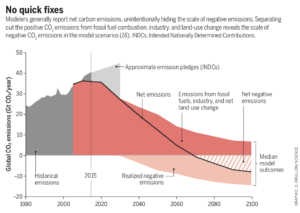Carbon
Carbon Cycle
Australia, as a signatory of the Paris Agreement has committed to future reductions in carbon emissions that will require net negative emissions in the second half of this century (Figure 1). Climate variability and change is likely to significantly modify natural land and ocean carbon sinks which will directly impact atmospheric CO²concentrations. Australia needs to reduce emissions to rely on both a reduction in Greenhouse Gas Emissions and enhancement of natural carbon sinks often termed “negative emissions” (e.g. land carbon farming). The activity utilised and extended the CAFE system to provide a novel perspective to historical variability in air-land and air-ocean carbon fluxes and evaluate the skill to deliver forecasts of these fluxes. Such information will be valuable to verifying regional CO² emissions in a future carbon constrained world. It may also aid Australia in developing policy to meet our future emissions targets accounting for climate variability and change.

Figure 1 – The pathway (net emissions) that are required to limit warming to “well below 2C” the stated goal of the Paris Agreement, and the anticipated fossil fuel reductions and negative emissions required to support this, based on the emission reduction pledges of individual countries (INDCs).
Reproduced from Anderson and Peters (Science).
Reproduced from Anderson and Peters (Science).
CSIRO has a long history of carbon cycle research involving land and ocean carbon modelling, and atmospheric and ocean carbon observations. We intend to direct our carbon expertise at the issue of predicting land-atmosphere and ocean-atmosphere carbon exchanges. This new activity on carbon cycle predictability is an integral part of the World Climate Research Program Grand Challenge on Carbon Feedbacks in the Climate System (https://www.wcrp-climate.org/gc-carbon-feedbacks). We will join a small group of modelling centres who are including the carbon cycle in their climate forecasting systems.
